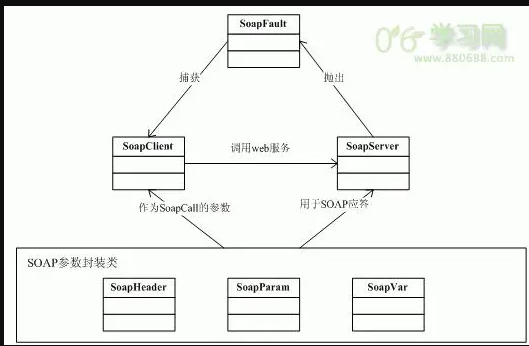You are here
PHP SOAP 扩展的使用 有大用 有大大用
原文地址:PHP SOAP 扩展,本文在原文基础上添加了一些内容和章节,也加入了一些注释,请读者注意。
前两篇文章 《SOAP 介绍》 和 《SOAP Web 服务介绍》 已经对 SOAP 相关知识做了比较详细的介绍。现在以 PHP 的 SOAP 扩展为例,综合运用一下学习到的知识。
简介
PHP 的 SOAP 扩展可以用来提供和使用 Web Services。换句话说,PHP 开发者可以利用这个 PHP 扩展来写他们自己的 Web Services,也可以写一些客户端来使用给定的 Web Services。
PHP5 中的这个 SOAP 扩展目的是为了实现 PHP 对 Web Services 的支持。与其它实现 PHP 对 Web Services 的支持的方法不同,SOAP 扩展是用 C 写的,因此它比其它方法具有速度优势。注:SOAP 扩展是在 PHP5 才开始提供,所以在此之前人们要使用 SOAP 去调用 Web Services 时,一般是使用第三方提供的 SOAP 封装库来实现,比如:NuSOAP。
SOAP 扩展支持以下规范:
SOAP 1.1
SOAP 1.2
WSDL 1.1
SOAP 扩展主要用来处理 RPC 形式的 Web Services。不过,你也可以使用文本形式的 WSDL 文件配合 WSDL 模式的服务端和客户端。
这个扩展使用 GNOME XML 库来处理XML。
扩展中的类
这个扩展实现了6个类。其中有三个高级的类,它们的方法很有用,它们是 SoapClient、SoapServer 和SoapFault。另外三个类除了构造器外没有其它别的方法,这三个是低级的类,它们是 SoapHeader、SoapParam 和 SoapVar。
SOAP 扩展关系图:
上图并不是很准确,因为 SoapServer 也可以在响应时发送 SoapHeader。所有会有下面这个更加准确的关系图:

SoapClient 类
这个类用来使用 Web Services。SoapClient 类可以作为给定 Web Services 的客户端。
它有两种操作形式:
WSDL 模式
Non-WSDL 模式
在 WSDL 模式中,构造器可以使用 WSDL 文件名作为参数,并自动从 WSDL 中提取使用服务时所需要的信息。
Non-WSDL 模式中使用参数来设置使用服务时所需要的信息。这个类有许多可以用来使用服务的有用的方法。其中 SoapClient::__soapCall() 是最重要的。这个方法可以用来调用服务中的某个操作。
SoapServer 类
这个类可以用来提供 Web Services。与 SoapClient 类似,SoapServer 也有两种操作模式:WSDL 模式和 non-WSDL模式。这两种模式的意义跟 SoapClient 的两种模式一样。在 WSDL 模式中,服务实现了 WSDL 提供的接口;在 non-WSDL 模式中,参数被用来管理服务的行为。
在 SoapServer 类的众多方法中,有三个方法比较重要。它们是 SoapServer::setClass()、SoapServer::addFunction() 和 SoapServer::handle()。
SoapServer::setClass()方法设定用来实现 Web Services 的类。SoapServer::setClass 所设定的类中的所有公共方法将成为 Web Services 的操作(operation)。
SoapServer::addFunction() 方法用来添加一个或多个作为 Web Services 操作(operation)的函数。
SoapServer:: handle() 方法指示 Web Services 脚本开始处理进入的请求。Web Services 脚本是用 PHP 脚本写的一个或多个 SoapServer 对象的实例。尽管你可以有不止一个的 SoapServer 对象,但通常的习惯是一个脚本只拥有一个 SoapServer 实例。在调用 SoapServer::handle() 方法之前,Web Services 脚本会使用设置在 SoapServer 对象实例上的任何信息来处理进入的请求和输出相应的内容。
SoapFault 类
这个类从 Exception 类继承而来,可以用来处理错误。SoapFault 实例可以抛出或获取 Soap 错误的相关信息并按程序员的要求处理。
SoapHeader 类
这个类可以用来描述 SOAP headers。它只是一个只包含构造器方法的数据容器。
SoapParam 类
SoapParam 也是一个只包含构造器方法的数据容器。这个方法可以用来描述传递给 Web Services 操作的参数。在 non-WSDL 模式中这是一个很有用的类,可以用来传递所期望格式的参数信息。
SoapVar 类
SoapVar 也是一个只包含构造器的低级类,与 SoapHeader 和 SoapParam 类相似。这个类可以用来给一个Web Services 操作传递编码参数。这个类对 non-WSDL 中传递类型信息是非常有用的。
注:SoapParam 和 SoapVar 主要用来封装用于放入 SOAP 请求中的数据,他们主要在 non-WSDL 模式下使用。事实上,在 WSDL 模式下,SOAP 请求的参数可以通过数组方式包装,SOAP 扩展会根据 WSDL 文件将这个数组转化成为 SOAP 请求中的数据部分,所以并不需要这两个类。而在 non-WSDL 模式下,由于没有提供 WSDL 文件,所以必须通过这两个类进行包装。
SoapHeader 类用来构造 SOAP 头,SOAP 头可以对 SOAP 的能力进行必要的扩展。SOAP 头的一个主要作用就是用于简单的身份认证。
WSDL VS. non-WSDL 模式
Web Services 有两种实现模式:契约先行(Contract first)模式和代码先行(Code first)模式。
契约先行模式使用了一个用 XML 定义的服务接口的WSDL文件。WSDL 文件定义了服务必须实现或客户端可以使用的接口。SoapServer 和 SoapClient 的 WSDL 模式就基于这个概念。
在代码先行模式中,首先要先写出实现服务的代码。然后在大多数情况下,代码会产生一个契约(可以借助一些工具生成),换种说法,一个 WSDL 文件。接着客户端在使用服务的时候就可以使用那个 WSDL 来获得服务的接口及其他信息。尽管如此,PHP5 的扩展并没有从代码输出一个 WSDL 的实现,考虑到这种情况,可以在 non-WSDL 模式下使用 SoapServer 和 SoapClient。
使用 SOAP 扩展实现 Hello World
这一节介绍如何使用 WSDL 模式和 non-WSDL 模式来实现服务和客户端。相对而言,使用 WSDL 模式来实现服务和客户端会比较容易,假定已经有一个定义好了接口的 WSDL 文件。因此这一节会先介绍如何使用 WSDL 模式实现一个 Web Service。
安装 SOAP 扩展
对于 Windows 平台,需要在 php.ini 中加入如下代码:
extension = php_soap.dll
上面的工作完成之后,还需要注意的是 SOAP 扩展在配置文件中有独立的代码片段:
这些配置项主要是用来指定 PHP 处理 WSDL 文件时使用缓存的行为。这几个配置项分别说明:是否开启 WSDL 文件缓存、文件缓存位置、缓存时间、以及最大缓存文件数量。启用缓存会加快 PHP 处理 WSDL 文件的速度,但最好在调试代码时关闭缓存,以避免一些因缓存行为而出现的问题。
WSDL 文件
在这个 Hello World 例子的服务中有一个被命名为 greet 的操作。这个操作有一个字符串形式的名字参数并返回一个字符串形式的 Hello + 名字。所用到的 WSDL 如下:
- <wsdl:definitions
- xmlns:impl='http://localhost/php-soap/wsdl/helloService'
- xmlns:intf='http://localhost/php-soap/wsdl/helloService'
- xmlns:wsdl='http://schemas.xmlsoap.org/wsdl/'
- xmlns:wsdlsoap='http://schemas.xmlsoap.org/wsdl/soap/'
- xmlns:xsd='http://www.w3.org/2001/XMLSchema'
- targetNamespace='http://localhost/php-soap/wsdl/helloService'>
- <wsdl:types>
- <schema elementFormDefault='qualified'
- xmlns:impl='http://localhost/php-soap/wsdl/helloService'
- xmlns:intf='http://localhost/php-soap/wsdl/helloService'
- xmlns:wsdl='http://schemas.xmlsoap.org/wsdl/'
- xmlns="http://www.w3.org/2001/XMLSchema"
- targetNamespace='http://localhost/php-soap/wsdl/helloService' >
- <element name='greet'>
- <complexType>
- <sequence>
- <element name='name' type='xsd:string' />
- </sequence>
- </complexType>
- </element>
- <element name='greetResponse'>
- <complexType>
- <sequence>
- <element name='greetReturn' type='xsd:string' />
- </sequence>
- </complexType>
- </element>
- </schema>
- </wsdl:types>
- <wsdl:message name='greetRequest'>
- <wsdl:part name='parameters' element='impl:greet' />
- </wsdl:message>
- <wsdl:message name='greetResponse'>
- <wsdl:part name='parameters' element='impl:greetResponse' />
- </wsdl:message>
- <wsdl:portType name='helloService'>
- <wsdl:operation name='greet'>
- <wsdl:input name='greetRequest' message='impl:greetRequest' />
- <wsdl:output name='greetResponse' message='impl:greetResponse' />
- </wsdl:operation>
- </wsdl:portType>
- <wsdl:binding name='helloServiceSoapBinding' type='impl:helloService'>
- <wsdlsoap:binding transport='http://schemas.xmlsoap.org/soap/http' style='document' />
- <wsdl:operation name='greet'>
- <wsdlsoap:operation soapAction='helloService#greet' />
- <wsdl:input name='greetRequest'>
- <wsdlsoap:body use='literal' />
- </wsdl:input>
- <wsdl:output name='greetResponse'>
- <wsdlsoap:body use='literal' />
- </wsdl:output>
- </wsdl:operation>
- </wsdl:binding>
- <wsdl:service name='helloService'>
- <wsdl:port binding='impl:helloServiceSoapBinding' name='helloService'>
- <wsdlsoap:address location='http://localhost/php-soap/wsdl/hello_service_wsdl.php' />
- </wsdl:port>
- </wsdl:service>
- </wsdl:definitions>
WSDL 模式服务端
下面是 WSDL 模式的服务使用 SOAP 扩展来实现提供服务的代码:
- <?php
- function greet($param)
- {
- $value = 'Hello ' . $param->name;
- $result = [
- 'greetReturn' => $value
- ];
- return $result;
- }
- $server = new SoapServer('hello.wsdl');
- $server->addFunction('greet');
- $server->handle();
在这个服务的实现过程中,函数实现了WSDL所定义的服务操作 greet,greet 操作有一个 WSDL 指定的参数,按照 greet 操作的语义,这个参数是一个用户的名字。最后 handle 调用了触发处理请求的服务对象。
WSDL 模式客户端
客户端代码如下:
- try {
- $client = new SoapClient('hello.wsdl');
- $result = $client->__soapCall('greet', [
- ['name' => 'Suhua']
- ]); // 记住第二个参数是双层数组,有大用
- printf("Result = %s", $result->greetReturn);
- } catch (Exception $e) {
- printf("Message = %s",$e->__toString());
- }
客户端代码中,首先创建一个使用 WSDL 文件作参数的 SoapClient 实例。接着使用 __soapCall() 调用 greet 方法,并传入参数。
下面是客户端所发送的 SOAP 请求:
- <?xml version="1.0" encoding="UTF-8"?>
- <SOAP-ENV:Envelope
- xmlns:SOAP-ENV="http://schemas.xmlsoap.org/soap/envelope/"
- xmlns:ns1="http://localhost/php-soap/wsdl/helloService">
- <SOAP-ENV:Body>
- <ns1:greet>
- <ns1:name>Suhua</ns1:name>
- </ns1:greet>
- </SOAP-ENV:Body>
- </SOAP-ENV:Envelope>
下面是服务端响应上诉请求而发送的 SOAP 响应:
- <?xml version="1.0" encoding="UTF-8"?>
- <SOAP-ENV:Envelope
- xmlns:SOAP-ENV="http://schemas.xmlsoap.org/soap/envelope/"
- xmlns:ns1="http://localhost/php-soap/wsdl/helloService">
- <SOAP-ENV:Body>
- <ns1:greetResponse>
- <ns1:greetReturn>Hello Suhua</ns1:greetReturn>
- </ns1:greetResponse>
- </SOAP-ENV:Body>
- </SOAP-ENV:Envelope>
上面的 SOAP 消息都是利用 WSDL 模式下的服务端和客户端来获取的(可以使用 __getLastResponse 和 __getLastRequest 这两个方法获取,前提是客户端初始化时,要把 trace 参数设置为 true)。也可以利用 non-WSDL 模式的服务端和客户端来产生与上面相同的 SOAP 消息。但是,PHP 代码必须有一点改变。下一节会说明如何使用 non-WSDL 模式。
non-WSDL 模式服务端
- function greet($param)
- {
- $value = 'Hello '.$param;
- return new SoapParam($value, 'greetReturn');
- }
- $server = new SoapServer(null, [
- 'uri' => 'http://localhost/php-soap/non-wsdl/helloService'
- ]);
- $server->addFunction('greet');
- $server->handle();
在 non-WSDL 模式中,像 WSDL 模式一样首先实现 greet 函数的功能,但是函数实现的方式跟 WSDL 模式稍稍有所不同。在 non-WSDL 模式中,我们必须返回一个 SoapParam 对象作为响应,而不是一个数组。创建服务时,第一个参数设为 null,说明没有提供 WSDL;接着传递一个选项作为参数,这个选项参数是服务的 URI。最后像 WSDL 模式一样调用剩下的方法。
non-WSDL 模式客户端
- try {
- $client = new SoapClient(null, [
- 'location' => 'http://localhost/php-soap/non-wsdl/hello_service_non_wsdl.php',
- 'uri' => 'http://localhost/php-soap/non-wsdl/helloService'
- ]);
- $result = $client->__soapCall('greet', [
- new SoapParam('Suhua', 'name')
- ]);
- printf("Result = %s", $result);
- } catch (Exception $e) {
- printf("Message = %s",$e->__toString());
- }
在 non-WSDL 模式中,因为没有使用 WSDL,传递了一个包含服务所在位置(location)和服务 URI 的参数数组作为参数。然后像 WSDL 模式中一样调用 __soapCall() 方法,但是使用了 SoapParam 类用指定格式打包参数。返回的结果将获取 greet 方法的响应。
注:客户端实例化时所传入的服务 URI,实际上,我们可以把它看作该服务的一个命名空间(namespace)。客户端所传入的 URI 必与服务端所命名的 URI 一样。
结论
这篇文章介绍了 SOAP 扩展,可以在 PHP 中通过它来提供和使用 Web Services。PHP SOAP 扩展的强项是它的简单和快速。使用 C 写的 SOAP 扩展来运行服务端和客户端是非常简单的。虽然 SOAP 扩展在处理一些简单的 Web Services 时很有用,但是当用它来处理所有的 Web Services 时就表现出它的局限性。WSO WSF/PHP 就是为了弥补 PHP 扩展的缺陷而开发的,它是开源的,可以实现 SOAP 类似的功能并且支持 MTOM,WS-Addressing,WS- Security 和 WS-RelaiableMessaging。WSO2 WSF/PHP 支持与 SOAP 扩展类似的 API。我们正计划将 API 打包起来提供跟 SOAP 扩展一样的 API,会用 C 来写。
来自 https://segmentfault.com/a/1190000003791120
https://blog.csdn.net/richardman/article/details/106733077

